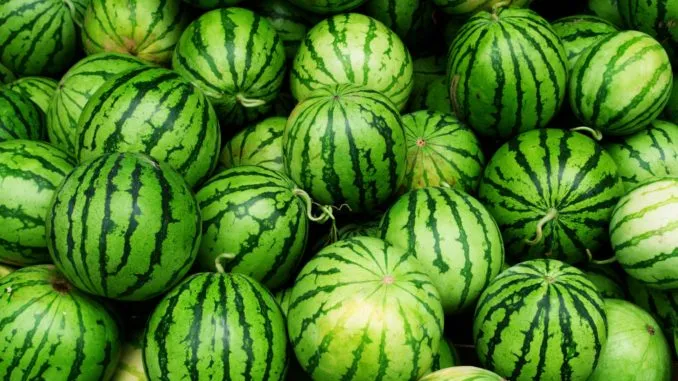Incorrect consumption of watermelon worsens gastritis symptoms, causing stomach pain and heaviness, especially if acidity levels are high. The fruit can be eaten depending on the individual's condition, presence of other gastrointestinal disorders, and disease stage.
Table of contents
Can You Eat Watermelon with High-Acidity Gastritis?
Nutritionists do not prohibit eating watermelon during disease remission or when symptoms subside. However, during a high-acidity gastritis flare-up, watermelon should be completely avoided.
For low-acidity gastritis, a few small slices per day are acceptable.

Pros and Cons
Watermelon provides essential nutrients and supports kidney function, which is important for various digestive disorders, including gastritis.
The fruit contains ascorbic acid and other compounds that may irritate the stomach lining. With high acidity, the diet should be gentle, and even small amounts of acid can worsen discomfort during flare-ups.
During remission, the stomach lining is no longer inflamed. Normal foods are gradually reintroduced to restore digestive function. At this stage, watermelon juice is acceptable in moderation.
Eating Watermelon with High-Acidity Gastritis
During remission or when inflammation subsides, watermelon should be eaten in small, controlled portions. Choose fully ripe, sweet fruit to avoid digestive irritation.
Properties
Watermelon’s sugar composition is unique—it contains easily digestible fructose, which is gentler on inflamed tissues than glucose. This makes watermelon a better choice than other sweet fruits for gastritis sufferers.
Benefits and Risks
Watermelon is beneficial for digestive disorders because it:
- improves gut microbiota;
- boosts metabolism;
- reduces overall digestive acidity;
- detoxifies the body;
- lowers cholesterol;
- enhances intestinal motility;
- supports cardiovascular health;
- provides B vitamins;
- aids weight management;
- has antioxidant and anti-inflammatory effects.
However, excessive consumption may cause:
- allergic reactions;
- kidney strain;
- toxicity (if contaminated);
- digestive upset.
Effect on the Stomach
Fruits naturally increase acidity due to their acid, fiber, and sugar content. They stimulate taste receptors, prompting higher hydrochloric acid production.
Note: Some nutritionists recommend eating watermelon on an empty stomach for detox, but this is not advisable for high-acidity gastritis.
Even without active inflammation, overeating watermelon may trigger heartburn—especially on an empty stomach. This is particularly risky with erosive gastritis.
How to Eat Watermelon Safely with Gastritis
Only introduce watermelon during stable remission. Avoid it if other digestive disorders (e.g., pancreatitis) are present.
Nutritionists recommend eating only the sweetest central flesh. Parts near the rind may contain nitrates, which are harmful, especially for sensitive digestive systems.
Recommended Intake
Moderation is key. Even in remission, excessive amounts can trigger symptoms. A safe daily limit is 500 g (2–3 slices).
Note: Never eat watermelon on an empty stomach—this may cause bloating or pain. Consume it as dessert instead.
Some experts allow small portions (up to 150 g) if no acute symptoms are present. Discomfort (heartburn, burping, or pain) means you should wait for full remission.
Watermelon During Gastritis Remission
Even in remission, avoid overeating. Small, frequent meals are ideal. Limit watermelon to 1–2 slices per day.
Chronic Gastritis
With chronic high-acidity gastritis, dietary mistakes can trigger flare-ups. Watermelon is allowed but must be strictly portioned.
Acute Gastritis
During acute phases, watermelon (like other fresh fruits high in acids and fiber) is forbidden until symptoms resolve.
Contraindications
Avoid watermelon if you have:
- acute or flaring digestive disorders;
- multiple concurrent GI conditions;
- kidney or urinary stones (risk of movement);
- severe digestive dysfunction (nausea, diarrhea).
Precautions
Choosing a safe watermelon:
- In Europe, peak season is late summer. Off-season fruit may be unripe or chemically treated.
- A ripe watermelon produces a hollow sound when tapped.
- When a flesh sample is soaked in water, it should cloud slightly—not turn pink (a sign of nitrates).
- The flesh should lack hard veins or unnatural sugar granules.
- Yellowish veins indicate chemical treatment.
Store cut watermelon refrigerated for ≤48 hours, wrapped tightly.
Watermelon for Other Digestive Issues
With low-acidity gastritis, watermelon is beneficial (up to 3 slices/day). Avoid it during acute inflammation.
Peptic Ulcers
During ulcer flare-ups, watermelon stimulates acid production, worsening pain. In remission, small portions (as dessert) are permitted.
Pancreatitis and Cholecystitis
For pancreatitis, eat only during remission. Avoid during flare-ups—it may cause severe pain.
Note: With cholecystitis, limit to 250 g/day in remission. Avoid if gallstones are present (risk of bile duct blockage).
Conclusion
Watermelon is acceptable for high-acidity gastritis in remission (2–3 central slices/day). Avoid it during flare-ups unless tolerated in tiny amounts (≤150 g). Always prioritize ripe, high-quality fruit and avoid overconsumption.







